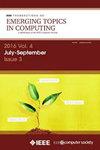DALTON - Deep Local Learning in SNNs via Local Weights and Surrogate-Derivative Transfer
IF 5.4
2区 计算机科学
Q1 COMPUTER SCIENCE, INFORMATION SYSTEMS
IEEE Transactions on Emerging Topics in Computing
Pub Date : 2024-08-27
DOI:10.1109/TETC.2024.3440932
引用次数: 0
Abstract
Direct training of Spiking Neural Networks (SNNs) is a challenging task because of their inherent temporality. Added to it, the vanilla Back-propagation based methods are not applicable either, due to the non-differentiability of the spikes in SNNs. Surrogate-Derivative based methods with Back-propagation Through Time (BPTT) address these direct training challenges quite well; however, such methods are not neuromorphic-hardware friendly for the On-chip training of SNNs. Recently formalized Three-Factor based Rules (TFR) for direct local-training of SNNs are neuromorphic-hardware friendly; however, they do not effectively leverage the depth of the SNN architectures (we show it empirically here), thus, are limited. In this work, we present anDALTON - 通过本地权重和代理-衍生转移在 SNN 中进行深度本地学习
由于其固有的时效性,直接训练脉冲神经网络是一项具有挑战性的任务。此外,由于snn中峰值的不可微性,传统的基于反向传播的方法也不适用。基于代理导数的时间反向传播(BPTT)方法很好地解决了这些直接训练挑战;然而,这些方法对于snn的片上训练来说并不是神经形态硬件友好的。最近正式提出的用于snn直接局部训练的基于三因子的规则(TFR)是神经形态和硬件友好的;然而,它们并不能有效地利用SNN体系结构的深度(我们在这里以经验来展示),因此是有限的。在这项工作中,我们提出了传统三因素规则的改进版本,用于snn的局部学习,有效地利用了深度-在分层学习特征的背景下。受反向传播算法的启发,我们从理论上推导了改进的局部三因素学习方法,称为DALTON (Deep local learning via local WeighTs and surroget -derivative TraNsfer),该方法使用了来自局部层的权重和proxy -derivative TraNsfer。与TFR类似,我们提出的DALTON方法也适用于神经形态硬件实现。通过在静态(MNIST、FMNIST和CIFAR10)和基于事件(N-MNIST、DVS128-Gesture和DVS-CIFAR10)数据集上的大量实验,我们表明,与传统的TFR实现相比,我们提出的局部学习方法DALTON有效地利用了卷积snn的深度。
本文章由计算机程序翻译,如有差异,请以英文原文为准。
求助全文
约1分钟内获得全文
求助全文
来源期刊

IEEE Transactions on Emerging Topics in Computing
Computer Science-Computer Science (miscellaneous)
CiteScore
12.10
自引率
5.10%
发文量
113
期刊介绍:
IEEE Transactions on Emerging Topics in Computing publishes papers on emerging aspects of computer science, computing technology, and computing applications not currently covered by other IEEE Computer Society Transactions. Some examples of emerging topics in computing include: IT for Green, Synthetic and organic computing structures and systems, Advanced analytics, Social/occupational computing, Location-based/client computer systems, Morphic computer design, Electronic game systems, & Health-care IT.
 求助内容:
求助内容: 应助结果提醒方式:
应助结果提醒方式:


